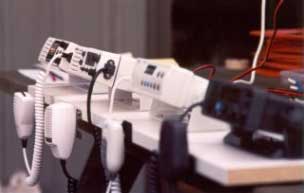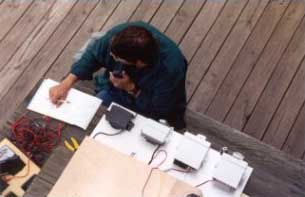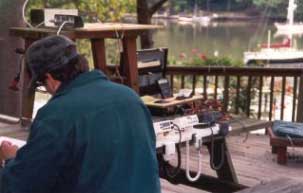Low-cost Marine VHF Radios
Foundation Findings #29 - January 1998
Next to life jackets and flares, the VHF marine radio is arguably the most important piece of safety equipment you can have aboard your boat. In some emergency situations, a VHF radio may be your only hope for help since the U.S. Coast Guard, marine police units and TowBoatUS operators monitor distress frequencies.
But the VHF has other uses, some critical, some merely convenient, like monitoring the weather, calling for drawbridge openings and - maybe - finding out where the fish are or even reserving a slip for the night.
Like most consumer electronics, the relative price of this vital piece of equipment has come down significantly in recent years. Today, there are over 100 models of VHF radios on the market in two categories, hand-held unit (See Foundation Findings #22, September 1995) and fixed mount radios meant to be wired into the boat's electrical system.

We chose four models, the Uniden MC 535, Apelco 4500, Standard Horizon Eclipse, and Shakespeare SE-2001. All the radios tested are rated by the manufacturer at 25 watts and each can be switched to the one-watt, low power mode for close-in operation and standby.
We tested the most important technical considerations for selecting a radio: power output, power draw, receiver sensitivity, and weather resistance. To that, we added subjective evaluations of reception quality and user friendliness. Our regimen consisted of bench tests under controlled conditions, at-sea broadcast trials, and a simple procedure to check weather resistance.
The units tested offer the full range of transmitting and receiving channels needed for recreational use in U.S. waters, plus 10 weather channels. All come with three year limited warranties.
VHF Primer
VHF (Very High Frequency) radios operate on line-of sight, meaning the signal is sent and received in a straight line. In practice, however, VHF radio waves can be slightly "bent" by the atmosphere, adding as much as 20% to a radio's range.
Range is primarily a function of the antenna to which the radio is connected. As a general rule, VHF's have a range of up to 20 miles, depending on the height of the antenna and its "gain" or ability to amplify the transmit and receive signals.
The Federal Communications Commission limits VHF radios aboard recreational boats to 25 watts maximum power and most units have a one-watt standby setting. Higher wattage does not necessarily mean greater broadcast range. Rather, the wattage boost you get at the high-power transmit setting pushes your signal through interference, usually nearby heavy VHF traffic.
It should be noted that a VHF radio's capability is only as good as the entire system - the power supply, cabling and antenna, all properly installed, shielded, grounded and weather proofed.
Bench Pressing for Power
Our technical team tested each radio in high-power transmit mode under simulated broadcast conditions in a fully equipped marine electronics shop. For these bench tests, we used power input levels to replicate three possible conditions aboard a boat, as follows:
- Engine running with properly functioning alternator, 13.6 volts.
- Engine off with fully charged battery, 12.6 volts.
- Engine off with battery in run-down condition, 11.6 volts.

Only one radio, the Standard, transmitted a full 25 watts of power at optimum operating conditions. (13.6 volts) Power output for the others ranged from 76% to 91% of their 25-watt rated output (see table for complete test results).
We also tested the power in amps each radio required while transmitting in both high and low modes, at the optimum operating condition, 13.6 volts. Here, the Standard used the most power, 5.45 amps in high mode and 290 milliamps on stand-by, while the Shakespeare consumed the least, requiring 4.4 amps and 160 milliamps, respectively.
Receiver sensitivity ranked very close among the four units. With a power supply of 13.6 volts, the Apelco ranked best but less than one percentage point separated the four units.
For good measure, we assessed reception quality the old fashioned way, by ear. To do that, we tuned each radio to three separate weather channels and took a consensus of sound quality among the technicians present. All proved quite acceptable.
Field Test
One radio in the boat is worth two on the bench so we developed a series of field exercises to test broadcast capabilities in the real world. For our mobile receiving station we used a 29-foot, twin engine powerboat outfitted with a typical array of electronic equipment, including a top-of-the-line VHF radio which features an LCD bar graph to measure incoming signal strength.
We established three receiving stations (on the Magothy River near Annapolis, MD) at the following distances: One-half mile on an unobstructed line-of-sight, one mile with a land mass between the test units and the boat, and three miles, again with land in between. We tested the radios on both high-power and low-power at each site.
At the half-mile mark, all units maxed the meter on both high and low power. At the one-mile stop, with houses and a marina as obstructions, the meter topped out with all units on high-power but at low-power the Uniden and Standard registered at 80% signal strength while the Shakespeare and Apelco registered at 50%. At the three-mile site on high power, Standard and Uniden registered 50% and the others registered 20%. On low-power, however, we were only able to communicate with the Standard radio and just barely, at that.
Soggy Signals
When it comes to weather/waterproof capabilities, the Uniden advertises a "splash-proof chassis" while the Standard makes no claims in its literature. Apelco and Shakespeare, however, say their radios meet the U.S. Coast Guard's water resistance standards for general electrical equipment in maritime use. But applying that standard would have meant hosing each radio with 65 gallons-per-hour delivered through a one inch nozzle for five minutes to determine if water could penetrate the unit.

That seemed too removed from real-world conditions for us so we just made it rain on the radios for a week. Using a simple spray bottle, we gave each radio a thorough wetting with brackish water periodically.
After that we tested each radio's operation, inspected them for corrosion and finally disassembled the units to look for water intrusion. None of the units nor the the microphones showed any water damage and each radio functioned as before.
So Watt?
For this Foundation Findings, it is important to remember that we tested four off-the-shelf radios selected much as you, the consumer, would.
Although nearly all fixed-mount marine VHF radios are rated at 25 watts, the consumer can't readily confirm actual output in the specific unit he or she may buy. But in real terms, the wattage variations we saw in our bench tests might only result in a relatively small difference in broadcast strength.
Depending on where you do your boating, this may not be the most important consideration. In fact, for a basic radio, the various features and functions of each (see table) or your personal tastes in styling and ergonomics may be more important criteria.
For example, you can change channels on both the Shakespeare and the Standard with buttons on the microphone, a very handy feature, but on the Uniden and Apelco you can't. And while many features are best evaluated by the purchaser, we did notice that the Uniden makes a beep when scrolling through the channels. We also should point out that while all the radios came fuse protected, only Shakespeare put the fuse close to the power source, rather than close to the radio.
All manufacturers provide adequate installation and operation instructions, we found, but Apelco's stood out for detail and clarity.
The BoatUS Foundation for Boating Safety would like to thank Tommy Closs and the staff at Electronic Marine Inc of Annapolis, MD for their technical advice and assistance in conducting bench tests.

